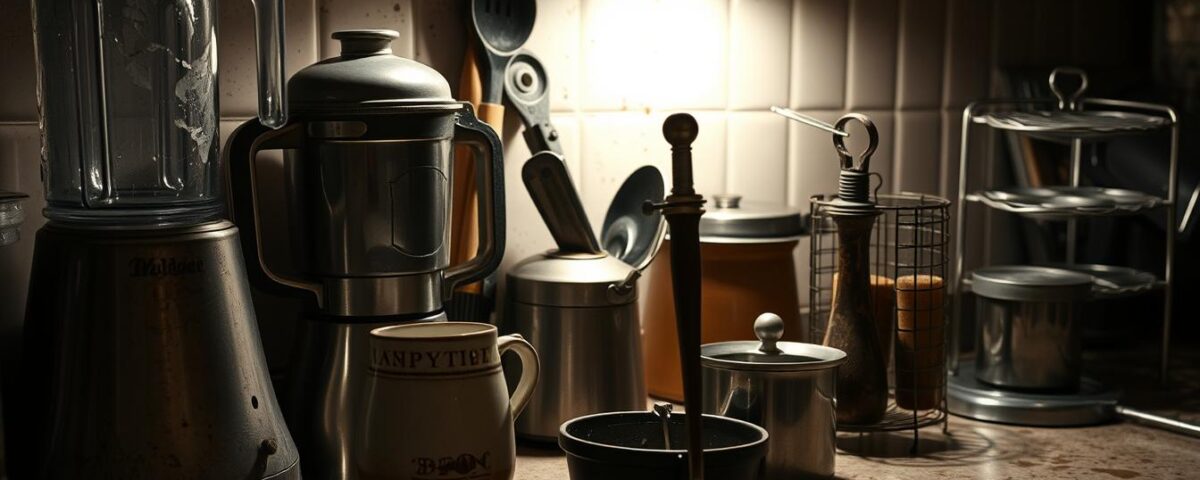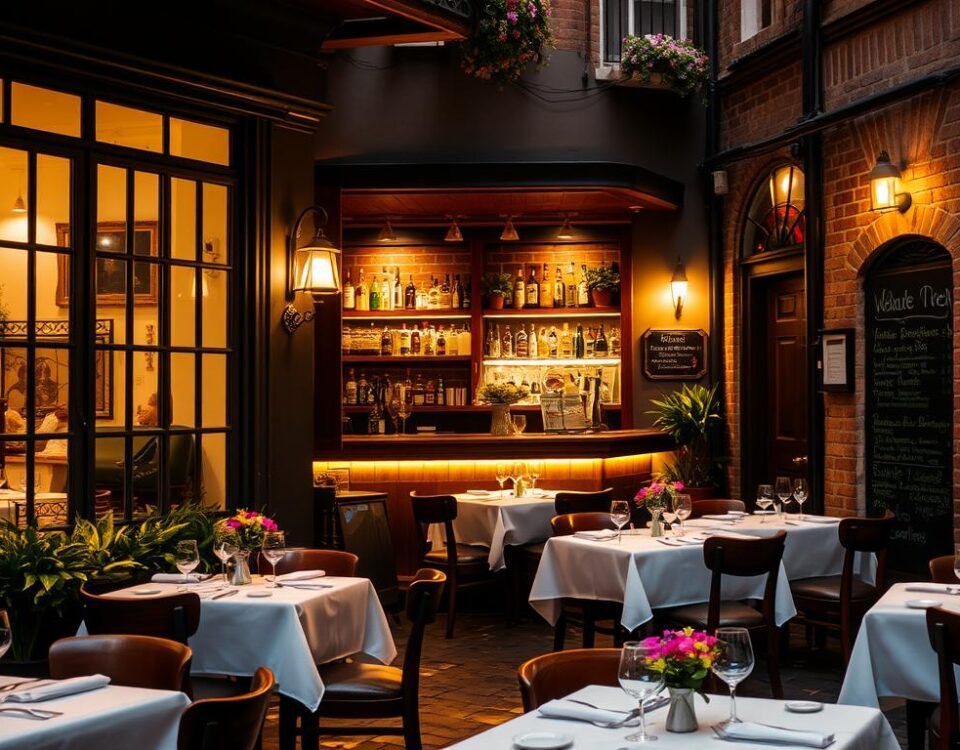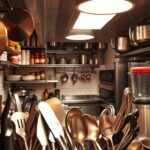
Top 10 Local Restaurant Supply Wholesalers You Need to Know
July 21, 2025
Why Participating in Restaurant Week Is a Game-Changer for Local Restaurants
July 22, 2025As a seasoned restaurateur, I’ve seen firsthand how the right kitchen equipment can make or break a business. When I opened my first restaurant, I was shocked to discover that equipment costs could account for up to 20% of the total startup expenses.
The market for used restaurant equipment has grown significantly, with many owners looking to save on costs without compromising on quality. Buying locally can offer unique advantages, including the ability to inspect items in person before making a purchase.
But is buying used equipment locally the right choice for your business? In this article, I’ll explore the key benefits and drawbacks to help you make an informed decision.
Key Takeaways
- Understand the advantages of buying used kitchen equipment locally.
- Learn how to assess the quality and lifespan of used equipment.
- Discover the potential pitfalls of purchasing second-hand restaurant equipment.
- Find out how to navigate the local market for used kitchen tools.
- Make an informed decision that suits your business needs.
Understanding the Market for Used Restaurant Equipment
As a restaurant owner, understanding the used equipment market can be crucial for making informed purchasing decisions. The market for used kitchen equipment has seen a significant shift, driven by both economic necessity and sustainability concerns.
The Growing Trend of Second-Hand Commercial Kitchen Equipment
The trend of buying used kitchen equipment is gaining traction among restaurateurs looking to cut costs without compromising on quality. Many restaurants close within the first few years of operation, often due to factors unrelated to the equipment. This creates a steady supply of nearly-new equipment entering the secondary market.
I’ve noticed a significant shift in the restaurant industry toward purchasing second-hand commercial kitchen equipment, driven by both economic necessity and sustainability concerns. The growing trend of second-hand equipment purchases is particularly strong among new restaurant owners and small businesses looking to maximize their startup capital.
Local vs. Online Sources for Used Equipment
When comparing local versus online sources for used restaurant equipment, I’ve found that local purchases offer the advantage of immediate inspection and reduced shipping costs. Local restaurant supply dealers often refurbish and test used equipment before reselling it, providing a level of quality assurance that’s difficult to find with online purchases.
Understanding the local market for used restaurant equipment requires building relationships with suppliers, attending restaurant auctions, and networking with other business owners in your area. This approach can help you find high-quality, lightly used equipment at a fraction of the cost of buying new.
Key Benefits of Buying Used Restaurant Equipment Locally
One of the smartest decisions a restaurateur can make is buying used restaurant equipment from local sources. This approach offers several significant advantages that can impact the bottom line and operational efficiency of a restaurant.
Significant Cost Savings Compared to New Equipment
Buying used restaurant equipment locally can result in substantial cost savings, ranging from 50-80% off the original price. For instance, a new commercial oven might cost $5,000, while a used one in good condition could be found for $1,500. That’s a savings of $3,500 on just one piece of equipment. When you’re outfitting an entire kitchen, these savings can add up significantly, allowing for better allocation of the budget to other critical areas.
Immediate Availability and Quick Replacement Options
The immediate availability of used equipment is a major advantage. Local purchases enable restaurants to acquire and install complete kitchen setups within days, rather than waiting weeks or months for new equipment deliveries. This immediacy eliminates shipping costs and reduces the time spent waiting for equipment to arrive, which is particularly valuable when you need to quickly replace a broken piece during busy service periods.
Potential for Finding High-Quality, Lightly Used Equipment
Many pieces of used restaurant equipment on the local market come from restaurants that closed for reasons unrelated to equipment quality. This means you can often find high-quality, lightly used items. Moreover, the maintenance history is often more accessible when buying locally, as you can speak directly with previous owners or maintenance technicians who serviced the equipment.
| Benefits | Description | Impact |
|---|---|---|
| Cost Savings | 50-80% off new equipment prices | Significant reduction in startup costs |
| Immediate Availability | Equipment available for immediate purchase and installation | Reduced downtime and faster kitchen setup |
| High-Quality Equipment | Lightly used equipment from closed restaurants | Better value for money and potentially longer equipment lifespan |
By considering these benefits, restaurateurs can make informed decisions about their equipment purchases, potentially saving money and improving their budget allocation. The savings from buying used equipment locally can significantly improve a new restaurant’s cash flow during the critical first year of operation, when money is typically tight.
Potential Drawbacks of Used Restaurant Equipment
While buying used restaurant equipment can be cost-effective, there are several drawbacks to consider. One of the primary concerns is the lack of warranty coverage and support, which can lead to significant financial burdens down the line.
Lack of Warranty Coverage and Support
When purchasing second-hand restaurant equipment, one of the most significant drawbacks is the absence of a manufacturer’s warranty. Unlike new equipment that comes with a warranty covering defects and malfunctions for a specified period, used equipment is typically sold “as-is.” I’ve experienced firsthand how the lack of warranty coverage can be a significant drawback, as any repairs or maintenance become my sole responsibility.
- The cost of repairs can be substantial, as I learned when I had to pay $800 for repairs on a used commercial mixer within the first month.
- The absence of a warranty means that I had to bear the costs of these repairs out of pocket.
Uncertainty About Equipment’s Past Use and Maintenance
The uncertainty about an equipment’s maintenance history can be concerning, as previous owners may have neglected regular servicing or used the equipment beyond its intended capacity. I’ve learned that hidden issues not apparent during inspection can surface later, causing unexpected downtime and repair costs that can disrupt kitchen operations.
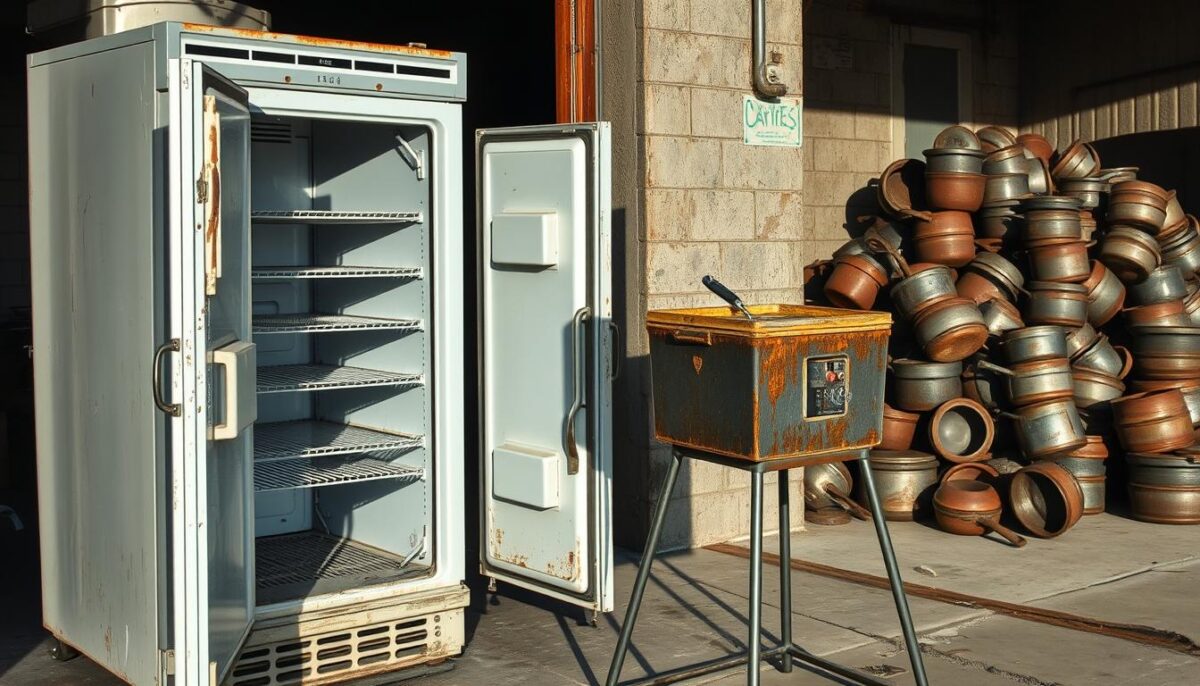
Potentially Shorter Remaining Lifespan
Even well-maintained used equipment inherently has a shorter remaining lifespan compared to new items, which means you may need to replace it sooner than anticipated. Finding replacement parts for older or discontinued models can be challenging and time-consuming, potentially extending equipment downtime during critical business periods. The cons of used equipment become particularly apparent when dealing with complex items that have multiple components that can fail, such as dishwashers or refrigeration units.
I’ve found that calculating the total cost of ownership, including potential repairs and maintenance, is essential when evaluating whether the initial savings of used equipment are truly worthwhile.
Best Types of Used Restaurant Equipment to Purchase
As someone who’s helped numerous restaurant owners source used equipment, I’ve identified key categories that offer the best bang for your buck.
Gas-Powered Equipment: Ranges, Ovens, and Fryers
Gas-powered equipment, such as ranges, ovens, and fryers, are among the best types of used restaurant equipment to purchase due to their durability and simpler mechanical components. In my experience, gas cooking equipment tends to have fewer electronic components that can fail, making them more reliable purchases in the used market.
Heavy-duty gas ranges from reputable manufacturers like Vulcan or Wolf can perform reliably for decades with proper maintenance. When purchasing used ovens, I look for commercial models with solid construction and simple controls, as they tend to hold up better over time.
Durable Kitchen Essentials: Worktables, Shelving, and Smallwares
Stainless steel worktables, shelving units, and other durable kitchen essentials are excellent used purchases because they have few or no mechanical parts to break down and can be thoroughly sanitized. Cast iron cooking equipment is another excellent used purchase I recommend, as these items often improve with age and can last for generations when properly maintained.
The type of kitchen you’re operating should influence your equipment choices – for high-volume operations, I recommend focusing on commercial-grade equipment even when buying used.
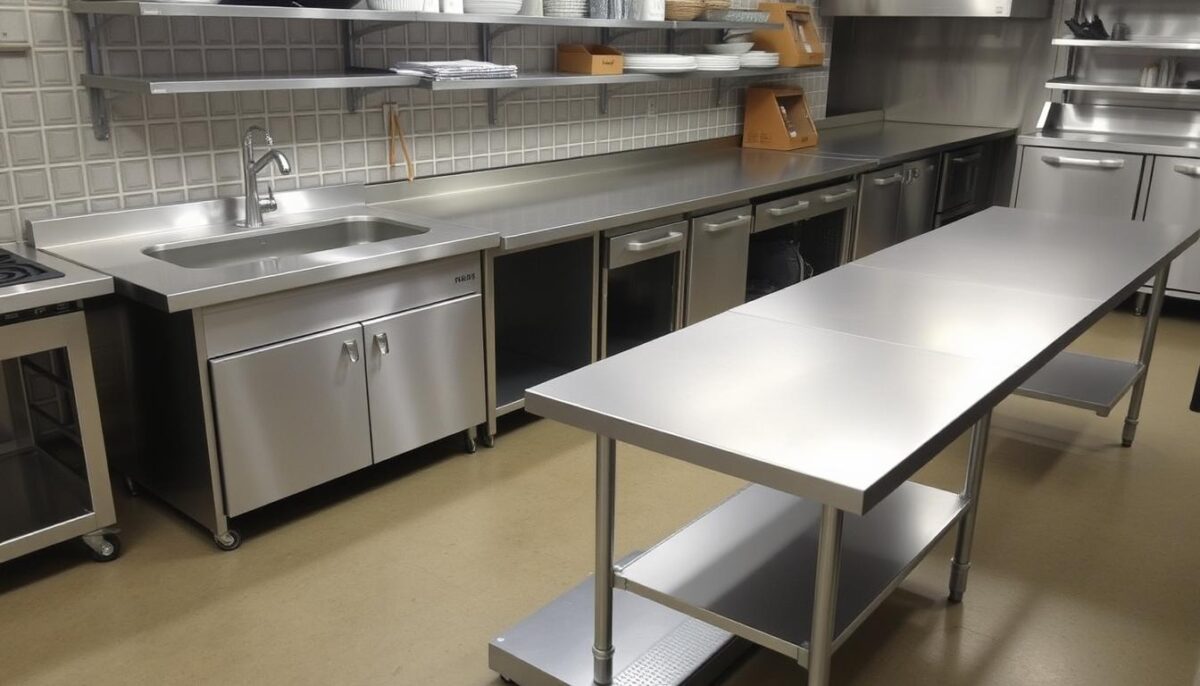
Equipment to Approach with Caution When Buying Used
Some used restaurant equipment types warrant extra caution due to hidden issues or high repair costs. When purchasing pre-owned equipment, it’s essential to be aware of the potential risks involved.
Refrigeration and Freezer Units: Hidden Issues and Costs
Refrigeration units are among the most critical pieces of equipment in a commercial kitchen, but they can also be among the riskiest used equipment purchases. Hidden issues like compressor problems or refrigerant leaks can lead to costly repairs or even food spoilage.
For instance, when I purchased a used walk-in cooler for a client, we discovered hidden refrigeration problems that cost nearly $2,000 to repair – almost as much as a new unit would have cost. The costs of repairing major refrigeration equipment can quickly erase any savings from buying used, especially when specialized parts are required or refrigerant needs recharging.
Electrical Equipment and Computerized Systems
Used electrical equipment with complex circuitry and computerized systems often present hidden issues that can be difficult and expensive to diagnose and repair. Equipment like dishwashers, which contain both plumbing and electrical systems, can develop problems over time.
I approach ice machines with particular caution in the used market, as they combine both refrigeration components and water systems that can harbor bacteria or mineral buildup. Similarly, equipment with digital controls and programming interfaces tends to be more problematic in the used market, as these components often fail first and can be expensive to replace.
When buying used kitchen equipment, it’s crucial to inspect the condition thoroughly and consider the potential for future repairs and associated costs. Being cautious and informed can help you make a more successful purchase.
Used Restaurant Equipment Pros and Cons: Evaluating Your Specific Needs
When considering used restaurant equipment, it’s crucial to weigh the pros and cons based on your specific business needs. As a restaurant owner, you need to assess various factors to make an informed decision.
Assessing Your Budget
Carefully evaluating your budget constraints and cash flow projections is essential before deciding between new and used equipment for your business. This assessment will help you determine whether the initial cost savings of used equipment outweigh the potential risks.
For instance, if you’re opening a new restaurant, you might prioritize budget-friendly options to minimize upfront investment. On the other hand, if you’re expanding an existing business, you might consider the long-term benefits of new equipment.
| Budget Considerations | New Equipment | Used Equipment |
|---|---|---|
| Initial Cost | Higher | Lower |
| Long-term Costs | Lower maintenance | Potential for higher maintenance |
| Warranty Coverage | Typically included | Usually not included |
Considering Your Restaurant’s Volume
When evaluating your specific needs, it’s essential to consider your restaurant’s anticipated volume and how intensively the equipment will be used. High-volume operations may benefit from new equipment with full warranty coverage to minimize downtime.
Balancing Initial Savings
Balancing initial savings against potential future costs requires an honest assessment of your business’s financial resilience. You need to consider whether you can absorb unexpected repair costs if they arise. I’ve helped clients save money initially with used equipment, but I always ensure they understand the potential long-term financial impact if the equipment requires significant repairs or early replacement.
- Evaluate your restaurant’s technical capabilities and access to reliable repair services.
- Consider creating a tiered equipment plan that identifies critical items versus those where used options present less risk.
- Assess the total cost of ownership, including potential energy efficiency differences between new and used equipment.
Critical Factors to Consider Before Purchasing Used Equipment
When buying used restaurant equipment, several critical factors must be considered to ensure a wise investment. As someone who has helped numerous restaurant owners navigate the process, I’ve identified key elements that can make or break the decision to purchase used equipment.
Equipment’s Age, Condition, and Maintenance Records
Carefully assessing the equipment’s age, overall condition, and maintenance history is crucial. I always request service records from the seller to verify that the equipment has been properly maintained and serviced throughout its lifespan. This information provides valuable insights into how well the equipment has been cared for.
Availability of Replacement Parts and Service Technicians
Researching the availability of replacement parts for specific manufacturer models is vital. Some brands maintain better parts availability for older equipment than others. I recommend confirming that qualified service technicians in your area are familiar with the specific brands and models you’re considering.
| Manufacturer | Parts Availability | Service Technician Availability |
|---|---|---|
| Brand A | High | High |
| Brand B | Medium | Medium |
| Brand C | Low | Low |
Compatibility with Existing Kitchen Setup and Utilities
I always check the compatibility of used equipment with existing kitchen setups and utilities, as retrofitting gas lines, electrical connections, or ventilation systems can add significant unexpected costs. Ensuring compatibility is essential to avoid costly surprises.
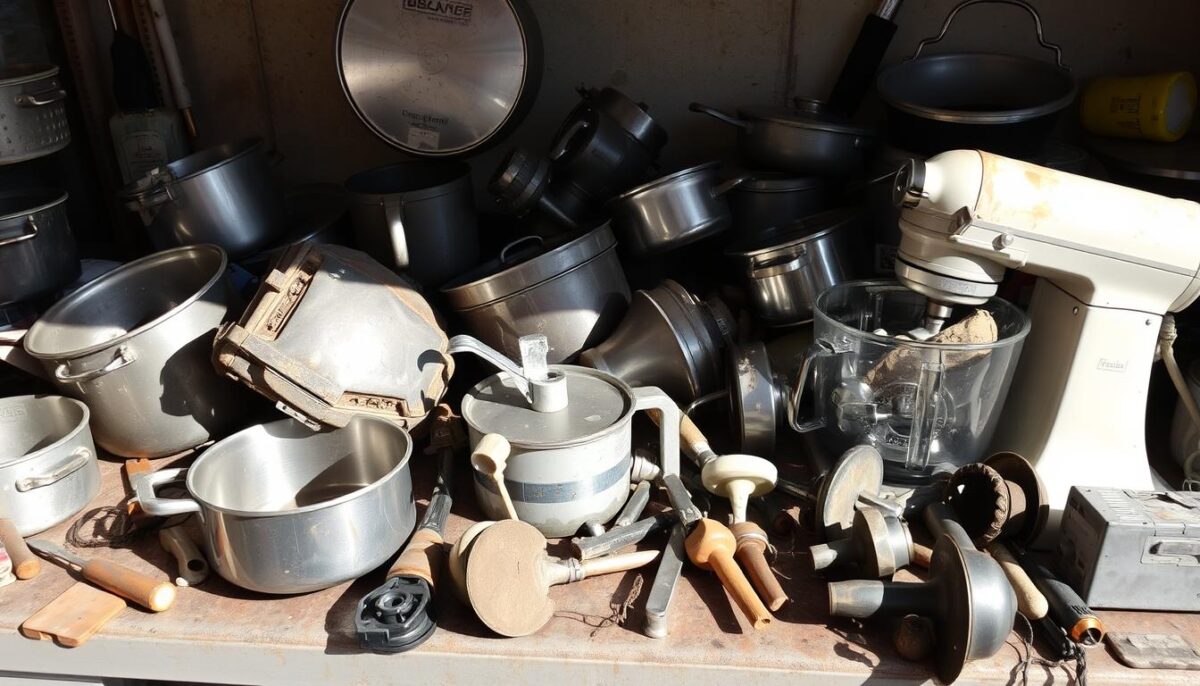
Total Cost of Ownership, Including Repairs and Energy Efficiency
When evaluating total cost of ownership, I factor in the energy efficiency of older equipment compared to newer models, as utility savings can sometimes justify the higher upfront cost of new equipment. Considering the total cost of ownership, including potential repairs and energy efficiency, is vital to making an informed decision.
By carefully considering these critical factors, restaurant owners can make informed decisions when purchasing used equipment, ensuring that their investment is wise and beneficial for their business.
Where to Find Quality Used Restaurant Equipment Locally
The search for quality used restaurant equipment locally can be streamlined by focusing on specific local sources. I’ve found that exploring various local channels can lead to significant savings and quick turnaround times.
Restaurant Supply Dealers and Authorized Resellers
Specialized restaurant supply dealers who deal in used equipment often provide the best balance of quality, price, and reliability for local purchases. When I’m helping restaurant owners source used equipment, I always check with authorized resellers who often take trade-ins and refurbish equipment before reselling it with limited warranties.
Restaurant Auctions and Liquidation Sales
Restaurant auctions and liquidation sales have been goldmines for finding quality used restaurant equipment at steep discounts. I once helped a client purchase a $10,000 range for just $2,800 at an auction. These sales can be a great way to save money, but it’s essential to inspect the equipment carefully before bidding.
Private Sellers and Online Marketplaces
When exploring private seller options, I’ve had success with both local classified ads and specialized online marketplaces that connect buyers with restaurant owners who are upgrading or closing. I always advise clients to inspect equipment in person before purchasing from private sellers, bringing along a knowledgeable technician when possible to evaluate the equipment’s condition.
To save money, I recommend building relationships with local restaurant equipment repair companies, as they often know about quality used equipment before it hits the market. Timing purchases around seasonal restaurant closures can also lead to competitive prices.
Conclusion: Making the Right Decision for Your Restaurant
As we conclude our exploration of used restaurant equipment, it’s clear that making an informed decision is crucial for your restaurant’s success. Throughout this article, I’ve explored the various used restaurant equipment pros and cons to help you make a smart choice for your specific business needs.
The pros of buying used restaurant equipment locally include significant cost savings and the ability to inspect items in person. However, it’s also important to consider the potential drawbacks, such as uncertainty about the equipment’s past use and maintenance. By weighing these factors and creating a detailed equipment plan, you can make purchasing decisions that support your restaurant’s long-term success.
Ultimately, the right decision varies based on your restaurant’s concept, volume, budget constraints, and risk tolerance. I encourage you to leverage the knowledge shared about where to find quality used restaurant equipment locally to maximize your chances of success.
FAQ
What are the benefits of buying used kitchen equipment locally?
Buying used kitchen equipment locally can offer significant cost savings, immediate availability, and the potential to inspect the equipment before purchasing. I can also get quick replacement options if something goes wrong.
How do I ensure the used equipment I buy is in good condition?
To ensure the used equipment is in good condition, I check its age, condition, and maintenance records. I also verify the availability of replacement parts and service technicians for the specific brand and model.
What types of used restaurant equipment are best to purchase?
Gas-powered equipment like ranges, ovens, and fryers are often good options, as well as durable kitchen essentials like worktables, shelving, and smallwares. These items tend to have a longer lifespan and can withstand heavy use.
Are there any types of equipment I should be cautious about when buying used?
Yes, I should be cautious when buying used refrigeration and freezer units, as well as electrical equipment and computerized systems. These can have hidden issues and costs associated with repairs or replacement.
How do I assess the total cost of ownership for used equipment?
To assess the total cost of ownership, I consider not only the purchase price but also the costs of repairs, maintenance, and energy efficiency. This helps me understand the long-term financial impact of my purchase.
Where can I find quality used restaurant equipment locally?
I can find quality used restaurant equipment locally through restaurant supply dealers, authorized resellers, restaurant auctions, and liquidation sales. I can also check with private sellers and online marketplaces, but I should be cautious when dealing with individual sellers.
What should I consider when evaluating my specific needs for used equipment?
When evaluating my specific needs, I consider my budget, the volume of my restaurant, and how I use the equipment. I balance the initial savings against potential future costs to make an informed decision.
